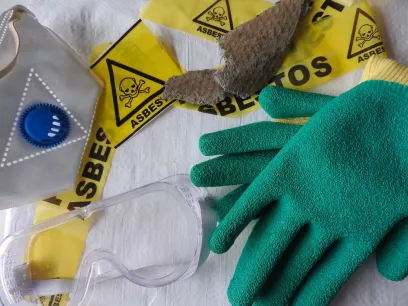How Asbestos Exposure Causes Mesothelioma

Injured?
While you may have heard that exposure to asbestos can be hazardous to your health, what you may not have heard is what this mineral actually is and what makes it considered a death sentence for thousands of Americans each year. Below, we are breaking down everything you need to know about the fibrous mineral, what signs concerning health symptoms you and your loved ones should look out for if you suspect you've come into contact with it, and how an attorney can help.
The Dangers Behind Asbestos
According to the New York State Department of Health, asbestos is a term applied to six cancer-causing minerals in rocks and soil, including actinolite, amosite, anthophyllite, chrysotile, crocidolite, and tremolite. This mineral is made up of long, thin, and strong fibers that do not evaporate or dissolve in water. The mineral fibers are also known for their resistance to heat, chemicals, electricity, and corrosion. These properties made the mineral a useful tool in creating durable building materials like roofing shingles, ceiling and floor tiles, insulation for furnaces, pipes, and walls, and more.
So, if the use of asbestos in certain materials was positive, what makes asbestos so bad for humans?
How Exposure to Asbestos Can Lead to Mesothelioma
As we know, asbestos has been classified as a known human carcinogen by the U.S. Department of Health and Human Services, the U.S. Environmental Protection Agency, and the National Cancer Institute. But what is a human carcinogen, and how does it connect to mesothelioma? Simply put, carcinogens are substances that may increase the risk of cancer developing in humans. In this case, asbestos, identified as a chemical human carcinogen, has been heavily linked to a form of cancer known as mesothelioma, more specifically, pleural mesothelioma.
How does asbestos lead to mesothelioma? Well, mesothelioma is caused by inhaling or swallowing asbestos fibers. The inhalation of asbestos does not just randomly occur; in fact, most cases of asbestos exposure occur when it is disturbed during situations like construction or the demolition of a structure. When asbestos is handled, its fine fibers are then released into the air, and those who are in the area will inhale the shard-like fibers. Those fibers will then stick to the protective mesothelium layers of the body's organs, where, eventually, they will create cancerous cells in the body.
What is Mesothelioma?
Mesothelioma refers to the tumors that develop in the mesothelium, which is a type of tissue that makes up the lining of cavities or hollows that protect and surround certain organs. Pleural mesothelioma, also known as "malignant pleural mesothelioma" is a cancer that grows in the membrane that lines the walls of your chest and lungs after exposure to asbestos. According to the Cleveland Clinic, there are an estimated 3,000 to 4,000 new cases of mesothelioma in the U.S. each year. Of those diagnosed, there are roughly 2,500 cases of malignant pleural mesothelioma.
Those diagnosed with malignant pleural mesothelioma have a life expectancy of about 18 months; however, medical journals report that many people die in the first four to six months after diagnosis and most by 12 months after diagnosis. Other forms of mesothelioma include:
- Peritoneal mesothelioma, which affects the tissue in the abdomen and pelvic area.
- Pericardial mesothelioma, which affects the tissue surrounding the heart.
- Mesothelioma of tunica vaginalis, which affects the tissue surrounding the testicles.
Commonly Reported Symptoms of Mesothelioma
According to the Mayo Clinic, symptoms may vary depending on the type of mesothelioma you may be diagnosed with. However, common symptoms of malignant pleural mesothelioma, which is typically associated with exposure to asbestos, include chest pain, excessive sweating, fluid in the lungs, shortness of breath, weight loss, and wheezing. Those who were exposed to asbestos and have developed pleural mesothelioma may not exhibit symptoms for up to 35 years after exposure.
If you were exposed to asbestos, we do not recommend you wait to receive medical attention, as exposure to asbestos can immediately affect your health. For more information about the risks of asbestos exposure, or if you believe you or a loved one were exposed, seek attention from a medical professional immediately, then contact a mesothelioma and asbestos exposure attorney.
In some cases, exposure to asbestos may also lead to other forms of health-related issues. At Morgan & Morgan, our attorneys are more than equipped to handle a variety of other cases related to your asbestos exposure. To learn more about how we help mesothelioma patients, connect with us today by completing our free, no-obligation case evaluation form.
When Are You Potentially Exposed To Asbestos?
Exposure to asbestos most commonly occurs when individuals are working on or near areas that contain trace amounts of the mineral in the materials being handled. According to the Occupational Safety and Health Administration, roughly 1.3 million employees in the construction and general industry, such as auto mechanics, maintenance workers, and refinery workers, are exposed to asbestos while on the job.
Disaster-related occupations such as firefighters, police officers, paramedics, and volunteer-based positions also create incredibly high risks of asbestos exposure. One of the most noted disaster events includes the thousands of first responders who were exposed to asbestos in 2001 after the collapse of the World Trade Center, which released a toxic plume containing 400 tons of pulverized asbestos and other hazardous materials across Lower Manhattan.
Other occupations also highly at risk for asbestos exposure include carpenters, demolition workers, drywallers, electricians, floor covering workers, furnace workers, glaziers, insulators, ironworkers, plant workers, painters, pipefitters, plasterers, plumbers, roofers, sheet metal workers, shipyard workers, steamfitters, tile setters, U.S. Navy personnel, and welders.
Exposure to asbestos does not end at work, as many individuals have reported exposure to asbestos at home during renovation projects, such as home demolitions and gardening. For more information on asbestos exposure and if you believe you may have been exposed, we highly encourage you to speak with an attorney today.
Were You Diagnosed with Mesothelioma? Connect with a Morgan & Morgan Attorney Today
At Morgan & Morgan, our attorneys have witnessed the devastating effects mesothelioma can have on patients and their loved ones. When working with our law firm, you can rest assured that our attorneys understand how crucial it is for those diagnosed with mesothelioma or their survivors to seek justice and compensation from those liable for their exposure to asbestos.
If you or a loved one has been diagnosed with mesothelioma due to exposure to asbestos, you do not have to go it alone. For over 35 years, Morgan & Morgan has been dedicated to helping our clients get the justice they deserve, and we want to help you, too. For more information on how a mesothelioma and asbestos exposure attorney may be able to help you, complete our free, no-obligation case evaluation form today.

We've got your back
Injured?
Not sure what to do next?
We'll guide you through everything you need to know.
